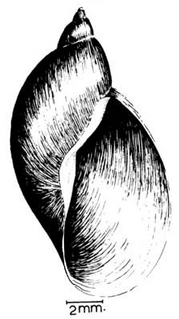| Oxyloma patentissima | |
|---|---|
 | |
| Drawing of an apertural view of the shell of Oxyloma patentissima | |
| Scientific classification | |
| Kingdom: | Animalia |
| Phylum: | Mollusca |
| Class: | Gastropoda |
| (unranked): | clade Heterobranchia clade Euthyneura clade Panpulmonata clade Eupulmonata clade Stylommatophora clade Elasmognatha |
| Superfamily: | Succineoidea |
| Family: | Succineidae |
| Subfamily: | Succineinae |
| Genus: | Oxyloma |
| Species: | O. patentissima |
| Binomial name | |
| Oxyloma patentissima (Pfeiffer, 1853) | |
| Synonyms | |
Succinea patentissima | |
Oxyloma patentissima is a species of land snail, a terrestrial pulmonate gastropod mollusk in the family Succineidae, the amber snails. [1]
In biology, a species ( ) is the basic unit of classification and a taxonomic rank of an organism, as well as a unit of biodiversity. A species is often defined as the largest group of organisms in which any two individuals of the appropriate sexes or mating types can produce fertile offspring, typically by sexual reproduction. Other ways of defining species include their karyotype, DNA sequence, morphology, behaviour or ecological niche. In addition, paleontologists use the concept of the chronospecies since fossil reproduction cannot be examined. While these definitions may seem adequate, when looked at more closely they represent problematic species concepts. For example, the boundaries between closely related species become unclear with hybridisation, in a species complex of hundreds of similar microspecies, and in a ring species. Also, among organisms that reproduce only asexually, the concept of a reproductive species breaks down, and each clone is potentially a microspecies.

A land snail is any of the numerous species of snail that live on land, as opposed to the sea snails and freshwater snails. Land snail is the common name for terrestrial gastropod mollusks that have shells. However, it is not always easy to say which species are terrestrial, because some are more or less amphibious between land and fresh water, and others are relatively amphibious between land and salt water.

Terrestrial animals are animals that live predominantly or entirely on land, as compared with aquatic animals, which live predominantly or entirely in the water, or amphibians, which rely on a combination of aquatic and terrestrial habitats. Terrestrial invertebrates include ants, flies, crickets, grasshoppers and spiders.















